Text
I think that all the themes that you listed are very interesting, I never really connected the fact that all the workers had their names revoked to taking away free will. I’ll have to disagree on one of your statements in your initial reaction, I do not really think that the themes of this movie are strong enough to overshadow the rest of the film. To say that adults might appreciate the movie for its themes more than children is a huge disservice to the film’s entertainment value. The film has a ton of tinier things that make the film more enjoyable, visual gags such as Chihiro hitting the wall after running up stairs, and smaller cute things such as the little tiny baby little birdy that looks like they came right out of Peep and the Big Wide World.


^literally the same
The film has a ton of these little things that all add up to a super enjoyable experience, to anyone watching, while letting the themes run in the background.
Hayao Miyazaki: Spirited Away
Initial Reaction
I had high hopes for Spirited Away, since a friend told me that this is one of her all-time favorite films. I must admit, I was not disappointed. There’s so much to analyze from capitalism, consumerism culture, environmental concerns, and human rights issues. One viewing for this film is not enough to uncover Miyazaki’s whole message. Although it is an anime, I feel that this is one that adults may enjoy and appreciate more than children for its social commentary. Nevertheless, it is a film that transcends age and national boundaries making it a film that anyone can relate to. Out of all the films we’ve watched this semester, this is one I plan on re-watching.
Social Commentary
The Importance of Your Name
The first scene, we, as an audience, encounter the importance a name holds is when Yubaba takes Chihiro’s name from her and renames her Sen. In the scene, we see Yubaba sucking up Chihiro’s name from the contract and leaving her with only a part of her full name. Interestingly, if you look closely enough, Chihiro misspelled part of her last name.
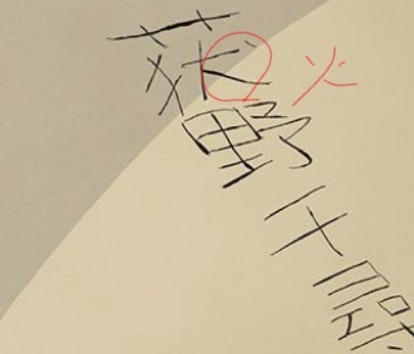
Though it is highly unlikely that she knew of the importance of retaining her name – Haku only warns her afterwards that Yubaba enslaves people by taking their name away from them – this emphasizes the idea that a name represents someone’s identity. In taking away names from her workers, Yubaba takes away people’s freedom of thought and free-will and disables them from questioning her authority much like the societal structure we live in today. This especially rings true in Japan’s society in which hierarchical structures are, in many cases, based off age. While this practice has its pros in that the population at large respect their elders, it also reaps problems in which situations that should be based on merit may be overridden solely by who in the group is the oldest. Chihiro represents the antagonist to such structures and is able to save her parents and Haku, because she stays true to herself and her values.
Money ≠ Happiness
Miyazaki quite obviously critiques the way in which capitalist society causes people to put money on a pedestal throughout the film’s screen time. This is prominently depicted in the scene where No Face shells out gold coins and the bathhouse workers immediately pick it up in a crazed manner. The workers only curry his (?) favor because they love his money and the status it brings him – not No Face, himself. Each mistakenly seem to believe that money will solve all their problems. After all, their lifestyle stems from only being able to work in a place that offers minimum wage at best and in which the working conditions are poor. However, Yubaba demonstrates that money may buy the tools to be happy, but does not necessarily correlate to a person’s level of happiness. Since, though, she may be financially well-off, she does not have enough time to spend time with her baby Boh who is the ultimate source of her happiness. In this sense, she also falls victim to the pitfalls created by capitalist societies.
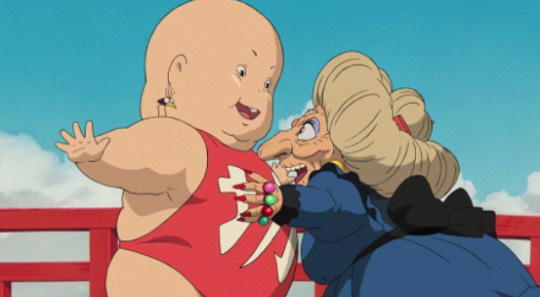
Also, can I just say that the ending song is exquisite!? It’s been one of my favorites for a long time, even though I had never watched Spirited Away the whole way through.
Here’s a link to a beautiful rendition by the original singer, Youmi Kimura: https://www.youtube.com/watch?v=kdO2X0QlYYI.
I also like this version by Ukrainian singer, Nataliya Gudziy: https://www.youtube.com/watch?v=xQJog0rs7Eg. The slower tempo fits the piece well and her personal connection to the lyrics represent the universality of Spirited Away’s themes.
10 notes
·
View notes
Text
Spirited Away
As an anime fan, I think it is a little weird that I have never watched a Studio Ghibli film before. Seen as one of the best anime movies ever, I was excited to watch Spirited Away, and I am glad to say, the movie lived up to the hype. The visuals were pleasing, the character design was good, the animation was amazing, and the story was really fun.
Animation is one of the most unique forms of art, combining the beauty of music, the meaning behind live action film, and the abstractions of reality that are scattered through paintings and drawings. Despite this, it is one of the least appreciated forms of art. Many people regard animation as a form of entertainment only for kids, a sentiment that plagues the quality of a lot of movies and shows. Adult cartoons in the west use really cheap, simple animation just to quickly create episodes to gain a profit, such as in shows like Family Guy, and 2d animation is being dropped by a lot of companies, such as Disney, who has not put out a 2d animated movie since 2009. This is a real shame, because 2d animation is one of the most expressive and unique forms of art. I think one of the best showcases for the magic of 2d animation is Japanese anime. While not the sole source of amazing 2d animation, anime has a large amount of amazing, expressive animation, like the awesome animation of Studio Trigger’s works. I think that Spirited Away is one of the best showcases of the wonders of 2d animation.
Spirited Away’s animation was really good, it helped build a unique world full of a variety of creatures. The art style is one of the more unique anime art styles, which helped the film stand out and create its own identity. I also really liked the character designs of the monsters, such as the funny looking frogs, and that one little bird that looks like a character from Peep and the Big Wide World. The story was really good, both recreationally and in a more “Scholarly” look. The movie can be enjoyed pretty easily by anyone, but the themes of greed are still present and noticeable, without being too explicitly stated. Chihiro’s parents turning into pigs due to their greed can be seen as both them “pigging out” on the food, or them being super greedy and digging into food just with the assurance that they have money to pay it off, and the main villain(?) is a greedy owner of a bathhouse, where all the workers are also insanely greedy when a rich person (or weird spirit thingy) shows up, which is a way more obvious depiction of the theme, which some could say is too cartoonish, but it still shows the theme throughout the movie. Overall, I really really liked the movie!
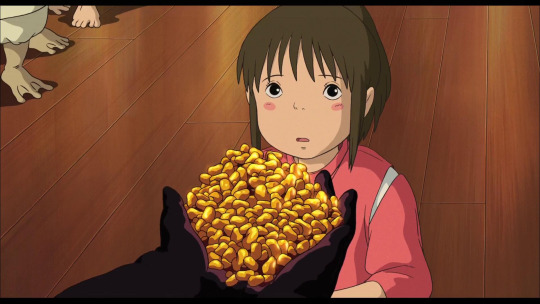
0 notes
Text
Since the movie was an adaptation of a Japanese story, all the characters were Japanese, but since the movie was a western style cowboy movie, all the characters spoke English. I thought that it was similar to the usage of other languages in Swallowtail Butterfly too, but there is no real reason other than the fact that this is a western style movie. I also don’t think it is fair to try and fit this film, or any film for that matter, into a specific genre. The movie definitely had both serious moments and comedic moments, both about death, and I don’t think the comedic moments ever cancel out the serious moments, or make it a comedy of any kind. The film has a weird relationship with the language it is told in, it is a completely different language than the original story, so they are self aware of it and poke fun of it in some places, such as the guy renaming himself to Henry, or the one white character speaking the only Japanese line. Since the film was overall an adaptation of a story, it kept the serious parts serious in order to adapt the plot, but it had fun with being a western version of an old Japanese tale. (ok wow why did i defend this movie so much i dont even like it)
Sukiyaki Western Django
I was very, very confused throughout the film, but I still enjoyed it. First of all, I have never seen a film where the entire cast is speaking only in a language that isn't their mother tongue (with the exception of Tarantino). I can't help but compare this aspect of the film to Swallowtail Butterfly. However, while Swallowtail Butterfly's non-Japanese speakers were raised out of Japan, all of the characters here are meant to be Japanese, or at least that's what I assume because they have Japanese-sounding names. They also incorporated Japanese tales into the plot. Why, then, were they using English?
We've discussed a lot in class about how the "New New Wave" of Japanese cinema were making films that were aimed at receiving international acclaim. Although the film is perhaps not the typical festival-winning film style we are used to, the fact that they could put together a fully English-speaking film showcases their ability and universality of the Japanese film industry.
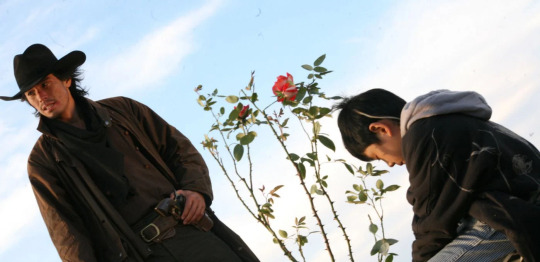
I’m not familiar with Westerns, Django, or Tarentino at all so I don’t know for sure if the film would have been easier to understand for those who did. But like I said before, whether or not the film was successful in making a film of its genre (Western/drama), its innovative ideas and commitment to the idea throughout is something to applaud. Like my classmates, I couldn’t tell if the film was trying to be serious or if it was self-aware of its ironic take the entire time. I find it hard to believe that the film I’m watching isn't a dark comedy when a guy’s head is cut open and he continues to clap his hands over his heads. Gunshots, stabs, and bleeding all follow a different biological rule than the one in our reality. However, any scene involving the son would draw me back in again. The fact that a child had to see and hear both his parents die horribly seemed like a plot that was too traumatizing to be put in as a mere comical scene.
Perhaps the film was trying to do both by telling the American Western story through the lens of a Japanese—someone who is an outsider. Elements like dragged out dying moments and amazing tricks with guns are things I associate with American westerns. These things aren’t realistic, but they’re filmed in a way to make us suspend our disbelief and enjoy them on screen. Sukiyaki Western Django, however, challenges us to see the ridiculousness of these classic film elements, yet asks us to appreciate them at the same time. It seems to be a great blend between the cultures that results in a uniquely wild product of entertainment.
3 notes
·
View notes
Text
Sukiyaki Western Django
Sukiyaki Western Django is just ok. It has a really interesting setup and idea but it failed to retain my interest, and a few decisions make the movie much worse.
The entire premise of the movie is a rendition of The Tale of the Heike in a western cowboy movie setting. This is shown really well throughout the film. The characters all have guns, and they all act like it is a cowboy movie. They still keep their names for the most part, but everything else is more cowboy like. They even have all the actors speak in English only, despite having an almost all Japanese cast. This was a good addition to the movie. I thought it was really interesting how they made the only Japanese line come out of a white person’s mouth. The movie also featured some smaller sets, which added to the whole cowboy movie theme.
This movie’s story was just ok. The story is based on the Tale of the Heike, but it does include some differences. Most of the time, the Heike and Genji are called the Red and White, and they wear those colors often. The movie adds some stuff to the story, such as a few third parties that are seemingly not in the original. A few of them are references to older cowboy movies, such as the unnamed gunman, who is the protagonist of the story, based on the trope from older cowboy movies of an unnamed gunman to just enter a town and make a plot to a movie. There is also a kid named Heihachi, which is a reference to the movie Django, which is revealed at the end. I do not watch cowboy movies so I only really knew about the gunman’s trope. I thought it was also interesting that the movie features Quentin Tarantino, who just 5 years later would make his own western style movie, Django Unchained.
I really did not like some of the things added to the plot. Specifically one singular scene, where Heihachi’s father dies. The specific act of Heihachi’s father dying is fine, but what happens after that felt really weird and unnecessary. This same thing is a problem in a lot of the older films in this class, but this film seems too recent to have a scene like that, it just felt really really weird and I did not like it at all. After finishing the movie, I can see why they did it, and I can see that it was not just added for no reason, it adds to the character’s motives, but I do not think it was a good thing for this film.
The film has a lot of cool moments, but overall just did not hold my interest the entire way through. The fights were very cool, but none of the characters were too interesting and I did not really care for the plot. The cinematography was good, especially with colors. The final scene where it starts to snow, as the gunman takes on the Genji leader, was a really cool use of color, followed by his death, a stark red on white of his blood.
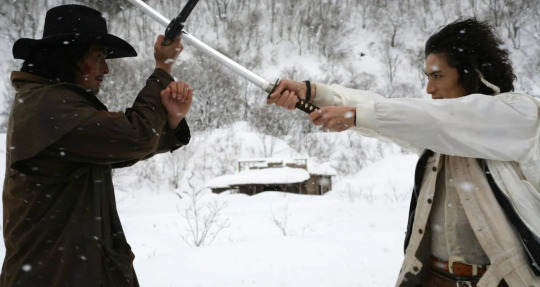
I may be biased due to how many good films I've watched in a row, I watched Sonic the Hedgehog 2 on Saturday (top 1 movie), Sweet Bean on Sunday, and then Spirited Away on Monday, so this movie is right next to 3 really good films, which may have influenced my take on it a little bit.
0 notes
Text
I don’t think I can agree any more with what you said, I loved this movie so much and I agree with pretty much everything that you said. I think its also interesting to note that the actor for Wakana is actually Kirin Kiki’s granddaughter, which may have made their moments in the film together much more natural.
あん – Sweet Bean
Yeah, this one broke me.
Absolutely beautiful film, truly bittersweet through and through. Really glad I stuck around to watch this on a bigger screen in an environment free from distractions, as it really allowed me to take everything in. A quaint story showcased through some really fine cinematography, the story hits all the right spots while not being too romanticized or pretentious about its contents. Tokue, played by the late Kirin Kiki, is the obvious star of the show, her character being wonderfully quirky and charming, and showing a group of people I rarely think about in general, let alone in Japan in particular.

An elderly woman who had been suffering from leprosy her entire life, it becomes obvious that the main source of grief was not from any of the physical effects, but rather the isolation and ostracization from society at large. It's clear that she's someone who cherishes every moment of life, and seeks to make the most of the time she has on Earth, bringing as much joy as she can to the people around her. Her meticulous process for making the sweet bean paste (あん) tells the audience everything they need to know about what kind of person she is. She talks to the beans and lets them sit for hours on end. “It would be rude to mix them straight away” she says, and settles in to wait a good few hours for them to cool. As skeptical as the shop owner Sentaro might be at first, he’s quickly accepting of her help and skills when the bean paste begins to bring in massive queues on the daily. The film just has a lot of heart and genuinely sweet moments. Seeing Tokue become filled with joy throughout her time working in the shop was really heartwarming, brief moments of her whispering lines to Sentaro like "This is fun" as she put stickers on the doriyaki bags as he flipped the pancakes really felt like a gutpunch of pure sweetness. I swear this movie could turn someone diabetic with how saccharine it can be, and I say that as a really good thing here. Not only did I think she was having fun, I felt like she was having the most fun she’d ever had in her life.
A young girl by the name of Wakana who frequents the Dorayaki shop befriends both Sentaro and Tokue, facing her own kind of outcasting, as does Sentaro, we found out more and more about each of their pasts, delivering many messages while never saying more than it needs to, it has just the right amount of dialogue while maintaining really transcendent moments of silence as well. The film explores some important issues with a lot of compassion, such as respect for one's elders knowledge and experience, prejudice and fear around disease and disability, ageism, the importance of patience, and joy in the little things in life. I found it refreshing to see a film that explored all of these things so gently and with a lot of humor along the way. The obvious heartbreaker at the end feels truly somber, but ultimately leaves us with hope for what's to come. Tokue found joy in her final days, and gave meaning to those around her to keep pressing on in life and sharing that same joy with those around them. Honestly getting a little teary eyed again writing all this. I think I could go for some Dorayaki now.
2 notes
·
View notes
Text
Sweet Bean
Sweet Bean was a charming movie, and honestly, a perfect one too. I really liked this film, it is my favorite film that I have watched for this class, and probably my 3rd favorite film of all time (the top 2 are reserved for Sonic 1 and 2, Sweet Bean’s lack of Sonic drops it down to 3rd). The entire film was calm without becoming boring, the cinematography was top notch, and it had a lot to say, and it said it all well.
Sweet Bean’s cinematography was probably my favorite aspect. The slow moving camera went well with the more calm story, and it helped me take in the surroundings. The lighting was the main star of the show however, the entire movie was so visually appealing. It was all bright and happy without hurting my eyes, even in scenes that take place in night. It felt like how Makoto Shinkai’s films look, but in real life (I had vivid picture mode on my tv, which may have made it look a little better than it actually is). The use of nature in a lot of shots added to the extremely calm feeling of the movie. The music helped to make the movie calm, but not boring. I love piano tunes, which took up most of the soundtrack of this movie, and it was delightful.
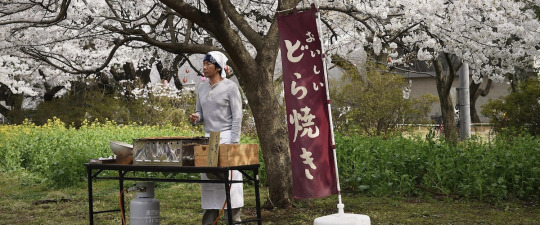
The movie has a few themes that I could pinpoint, with the main theme being the relations between different generations. In the film, the main 3 characters are all from different generations. Wakana represented the younger generation of schoolchildren, Sentaro is from the generation that is currently out of school and working, and Tokue is from the elderly generation. All 3 of them become friends and interact with each other throughout the movie. The movie also deals with the discrimination of disabled people, mainly people with leprosy. The movie manages to tackle these issues while maintaining interest, which made me like the movie a lot.
Something I thought was interesting was what the movie had to say on leprosy. The movie noted that lepers might lose their fingers or nose, and that these people are sometimes discriminated against because of how they look. It reminded me of a tweet that I saw a few years ago on the Japanese side of Twitter, linking to an article on the villain in a recent Hollywood movie at the time, calling for movies to not use face disfigurement to show that a character is evil. I made that connection when Wakana was reading the book on leprosy. It is nice that this movie tackled this issue.
What made me love this movie was definitely Tokue. She was really happy throughout the film, and it was nice seeing her teach Sentaro how to make the paste. It reminded me a lot of Tampopo at the beginning. I think that I also just enjoyed her character because she was old. I have nothing to add here I just really like my grandparents and she reminded me of them (as do most old people).
also I really want the bluray for this movie but it looks like its only available in region 2 (the UK) so I can buy it but I won’t be able to play it :(
0 notes
Text
I 1000% agree with what you said about the characters, I have not watched many horror movies, but the ones I have watched (Ringu and A Quiet Place) are infuriating because its not me watching something that will scare me its me watching people make bad decisions and crying/dying because of it that’s not scary or fun ( sorry had to rant i despise A Quiet Place why do they have a baby if they know that theres scary sound monsters het ppl are weird) but I dont agree on what you said was the message. I think it may have had more to do with loneliness, and definitely they had technology as part of it, but I feel like it was probably trying to be more about how being terminally online is bad or at least being lonely is a real problem. I also heavily disagree about ring being entertaining, they literally just go place to place and talk and then one person hugs a skull and theres the interesting story of Sadako and the tv stuff (sorry im ranting again ). Finally, I heavily agree with your last point. Creepypastas on the internet have pretty much ruined a lot of horror stuff, and technohorror (the genre of this movie) does not age well at all.
Pulse (2001)
I really am not a fan of horror movies in general, especially ones that are monster/ghost related, so Pulse really didn’t do anything for me. I found it incredibly boring, felt like it dragged on for so long, and there was a lot of time where there was very little happening. Not even just slow scenes, but just extra long shots that could have been cut half.
It seems that the Japanese horror movies (at least the two that we watched in class) are a lot slower paced than those of Hollywood, and that is perfectly fine. I love a good slow burn movie, for example the crime drama Knives Out has a 2h10m runtime and I love it, but for the slow burn effect to work I have to actually get invested and like the plot. I can’t say that Pulse got me invested at all. I didn’t hate the characters as much as I did in Ringu, they didn’t seem to make such stupid mistakes in general, and a lot of them died by happening to see the forbidden room or trying to help their friends, so that’s a plus.
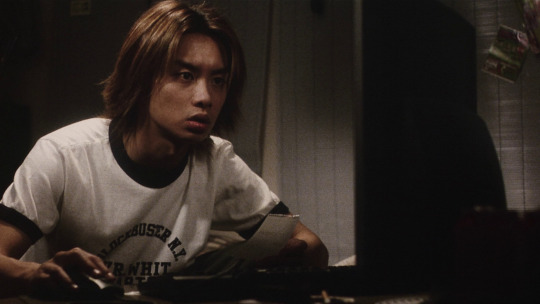
The only theme I could sus out for this film was “technology bad”. There was some talk about a lack of connection and the ghost phantom thing making people feel extremely lonely. All of this happened based around the internet/computers, so the connection I made is something along the lines of technology leads to isolation of individuals, even if there’s a promise of connection through it. Other than that, the film was incredibly boring and a bit confusing. Everyone just kinda died? Like the whole world? I’m not sure if I missed something or that was just out of the blue like it felt. By the time we got to the end of the movie I had completely forgotten it started with that opening boat scene, so when it finally got there I realized just how horribly this film dragged.
I will admit that the scene with Harue towards the end where she’s back in her computer room and sees herself on the screen before going to the door was really cool. I thought the way it was shot was really interesting, and I guess if I was invested in the story or was someone who was scared by the film, it would have been a super tense moment. Realistically though, that’s the only part of the film that stood out to me in a positive way.
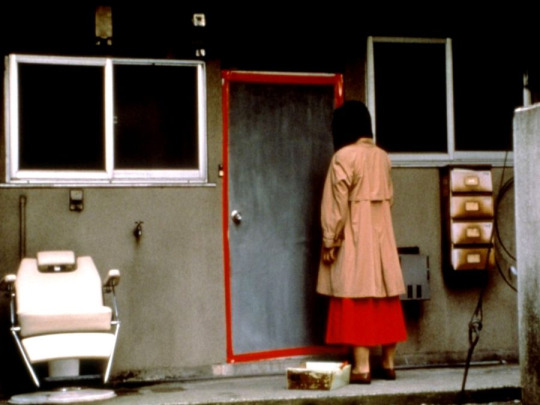
Again, I think that the main reason I didn’t like this film was because I don’t like horror movies in general. I think if I did, I would have been able to get invested in the plot and the plight of the characters, and maybe would have better things to say about it. Between this and Ringu,I think I preferred the latter. At least that one was more entertaining for me, it felt like more happened and I could at least hate the characters. Pulse just felt so boring and I couldn’t help but be disinterested and keep checking the time.
I think these two movies also both suffer from the time they were made. I don’t mean this from a technical standpoint, but the fact that the idea of chain mail, copypasta, “this thing will get you if you see this” type horror like Slendman, Jeff the Killer, and Momo challenge is something I’m so jaded to now having been around it my whole youth on the internet. I can see the idea of this being way more terrifying for adults/teens when the internet was still young and something like this wasn’t as common.
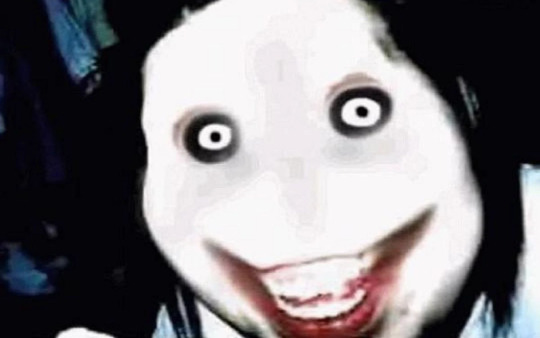
All in all, not a fan.
1 note
·
View note
Text
Pulse (2001)
Pulse is a good movie and a fine horror movie. The movie isn’t too scary, but it has interesting concepts, and an interesting message to say too. The movie also wasn’t boring overall. While the movie is supposed to be a horror, I did not find too much of it to be horrifying, but it did bring a horrifying way to die.
The horror in this movie was pretty light, but having loneliness be the killer was a unique choice, and it made the movie more interesting overall. I thought that the way people died in this movie was way more tense than something like Ringu, in Ringu the impending doom is just a date, and no one really shows any signs of changing from viewing till death, whereas in this movie, after encountering a ghost, the characters seemingly become apathetic, followed by death. The movie uses this well in some situations, such as using suicide for those who went into the room with red tape. The movie only uses it twice, but the characters commit suicide, followed by their disappearance, which I thought was an interesting choice, but not all of the characters who die do this. A few of the scenes totally took me out of the movie, mainly with the special effects. It makes sense for 2001, but nowadays this looks like something I could do in my free time, it made me laugh a lot. Another part that did not exactly hit the mark was when one of the characters rushes into one of the red tape rooms to save another character, there is a ghost in a black cloak that is hidden in plain sight until the camera focuses on it, which is supposed to be a spooky reveal, but I burst out laughing.
The movie’s message is that loneliness kills, but the movie conveys it in a really weird way. The first victim’s death is after he stays at his home for a long time, which is a good showcase, but another one of the victims really just dies despite not being too lonely before he dies, and people even ask if he’s ok and see him multiple times before he dies. The message is communicated verbally, which is fine for this movie, since it would be hard to convey that only through actions, but I wish that it conveyed it more through the story, while also dropping in the few lines about it.
The movie’s pacing was a little weird, I did not get too bored at any time, but there were some parts where I was just sitting and waiting for the next part. There were also way too many characters, I did not catch a lot of their names, since it’s hard for me to remember names, both in real life and in movies and shows (it takes around 12 anime episodes for me to remember the names of every main character in a show, more for side characters).
The cinematography was really good, I liked a lot of the shots that were taken through windows, the usage of limited view was a really good addition.
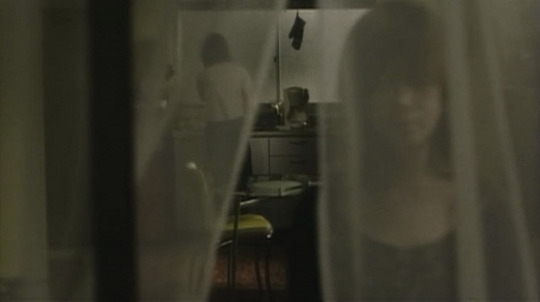
Finally, an interesting fact about the movie: Ryosuke Kawashima has a playstation console, and the movie shows one of the games for a few seconds. The game in question is Nanatsu no Hikari, a Sega Saturn and Playstation game that only released in Japan. The game is a Survival horror, which could be why it was specifically put on set, but the story does not really match anything in this movie.
1 note
·
View note
Text
idk if horror is for me lol i watched 2 horror movies and neither have scared me :> (the other one i watched was a quiet place)
0 notes
Text
While I didn’t think the movie was that scary (idk i dont think i like horror movies that much), the number symbolism(?) in this movie is really interesting! I knew that 4 is related to death in Japanese but I didn’t know about the other stuff
Ring....
Well… that was scary. I thought it would be worse but it was still quite scary…
I don’t really want to look up photos of this movie and accidentally run into frightening screencaps, so no pictures in this blog post. However, because I wasn’t looking at the scary things, I was instead focusing on the use of numbers in the film which ended up being quite interesting.

Numbers:
B4
Let’s start off with the first number in the film: B4. Honestly, this number has two interpretations - one in English and one in Japanese. In English, the hidden meaning is quite clear: B4 = Before. Yet, it isn’t until the end of the movie that the viewer realizes that this is a hint into where the body is since it is found under the building labeled B4. The Japanese meaning takes a bit of thought but, I believe it could be a play on the number “24″. In Japan 24, is considered an unlucky number because it sounds like “two deaths” (ni-shi). 4 will come up a lot in this film since it is the most unlucky number since it sounds like “death.”
54-4226
Breaking the numbers into parts, 54 is the first combo in this sequence. While this is technically a stretch, this could be a multilingual joke on “go die” with 5 = go and 4 = shi.
42 is actually a restricted number in japan since it sounds like “to die” and is never used as the last numbers on a license plate (note that these numbers appear in the middle to make it plausible)
26 is an interesting last number combo to appear since 26 in numerology is typically associated with doomsday. This is because 2+6=8 and 8 is thought to be the number of disaster.
7:01 (some time after seven)
The main protagonist’s time of watching the film and predicted time of death is tied to the number 7 for the number days of the week, which are also the days she has left.
77-3265
At the end of the film, the license plate on the car changes to show this one which is absent of the number 4 - predicting no death is on the horizon. Other than the absence of the number 4, I think the 77 is supposed to bring comfort and good fortune at this point in the film.
6 notes
·
View notes
Text
Ring (1998)
The movie Ring was a huge disappointment. I do not watch horror too often, and I am not too good with horror (I have fnaf nightmares), but I was not scared at all by this movie, or by its concepts.
The movie’s premise feels like it would not work in an actual setting. I do not think that every movie has to work in a real life setting, exaggerations in actions and thought processes can add to a film’s tension and action, but I do not think that this works well for horror. Horror movies have one main goal, to make you feel scared. This can be done in multiple ways, mainly by making you feel scared by what you see, or by making you feel scared by what could happen. This movie does not do either well. The movie’s premise falls apart when applied to a real life situation. If a tape kills someone in 7 days, it would either be seen as a weird coincidence after one or two people die from the tape, or it would be on national television if it was something proven that sweeps the nation, or a small town. Instead of doing either of these, the movie decides to have the main character look into the tapes herself after the police could not find anything. This would be fine, but I believe that due to the specific circumstances in the movie, in which the main character’s niece is a victim of the tape, makes it seem like a very disrespectful thing to do. As of the point in the film, no one knows for sure if the tapes are the killers, but directly after attending the victim’s funeral, the main character immediately tries to look for a supernatural tape, something that feels very disrespectful to her death if this were to happen in the real world. Since the concept does not scare me, I thought the imagery would, but it turns out that it does not. The movie only has one piece of imagery that is unsettling, which would be Sadako, especially her nails. The scene where she escaped the TV was a neat piece of special effects. Besides that, the movie is not scary at all. One part that tries to go in for a scare is the way that the affected people are identified. When they have a picture taken of them, they have smeared faces. This is an interesting piece of imagery, but nothing more. It literally just looks like the liquefy tool from many image manipulation programs. Another part which I assume tries to scare me is the vhs tape that is the center of the curse. The tape is interesting but it is not scary whatsoever. I was absolutely not scared during this movie, which is a big problem for a horror movie.
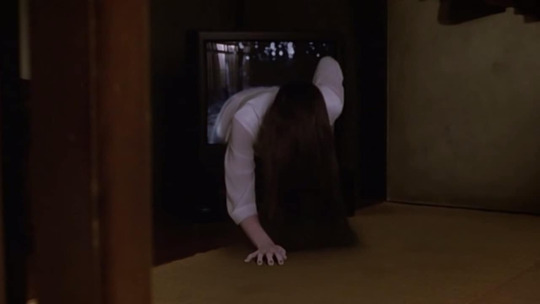
Persona 4
0 notes
Text
I agree with everything that you said, but also I never thought about the use of ambiguity in that way, with both Ageha’s heritage and the unfinished plotlines, really adds to my opinion on the movie.
Swallowtail Butterfly – スワロウテイル
A wonderful mess, that’s how I could describe this film. A world that is dirty, cruel, unforgiving, and beautiful all the same.
The movie went on for quite a bit, but it used all of that time pretty wisely to really flesh out the world they were trying to depict, a world showcasing a wide breadth of humanity, extending past nationality, race, class, gender, and language. Really, characters were speaking Japanese, English, Mandarin, or Cantonese, so I’m very impressed with the dialogue and how it was handled here. Language is played around with quite a bit as well, in particular with the name of the city and the immigrants, the city has the nickname of Yen Town (円都, en to), and the immigrants are referred to with a loose homophone Yen Thieves (円盗, en tou) which is anglicized as “Yentown” in dialogue and subtitles. Many different characters clung and clashed with each other in this bizarre but inspiring plot, and if this film did anything well, I think it allowed every character to have their chance to shine.
It's like multiple genres are belnding together to tell this tale. Characters start off mostly supporting one another until they all gain a path to fortune that allows them to realize their various dreams, but this comes at the cost of their solidarity with one another. With Glico we have a distinct musical element, with Ryo Ranki and Fei Hong we have a crime drama, and with Ageha we have something of a social realist journey. While Ryo certainly has some antagonistic qualities, I couldn’t really pin him as the villain, just another character in the film, and in a way the protagonist of his own story, just as any of the central characters were. Everyone is finding their own way, living the lives they want to live the way they want to live them.

One thing that was always shrouded in ambiguity was Ageha and her actual heritage, we never find out if she was Japanese or an Asian immigrant, and this was certainly by design. Her actual bloodline is not important here, she is from Yentown, that is her home and something she learns to hold onto with pride. It’s a bold statement that stands against the stubborn ideology of Japan surrounding racial purity and only valuing a specific birthplace. She manages to find a path forward in life that is fulfilling for herself and allows her to hold those she cares for close to her, and it has nothing to do with her race or nationality, but the resolve she gains from her experiences. She was forced to confront her own set of issues on her own and managed to help the people close to her along the way. Despite how wild the events got, I think her growth and resolve was great to witness, and she ended up being a wonderful protagonist.
In the end the animosity anyone held has vanished, and we were left to wonder how this world might progress in the future, as they left some plotlines up in the air. I don’t think it was necessary to know Ryo Ranki’s fate, or the fate of the other Yentowns. We already saw the most important parts of these characters and what the film really had to say about them, that is their journey, not their destination.
9 notes
·
View notes
Text
Swallowtail Butterfly
Swallowtail Butterfly was a film that I did not expect to like. While they have their place, movies like Life of Oharu, where a person wronged by societal norms suffers, is not really interesting to me. I can appreciate the messages of those films, but often times they just are really boring, especially Life of Oharu. When this movie started, I thought that this movie would be like that, but I was delightfully wrong. This movie’s plot was really wacky in some parts, and overall was an enjoyable experience.
The plot was probably my favorite part of the movie. While there is some serious stuff, a lot of it is coated in comedy. Something like a person’s death is framed in such a way that his fall makes me laugh. This keeps the movie interesting, never boring me. One part that I learned after the movie finished was that in Japanese, the Yentown area is a different word than the people that were called Yentowns, with the place being en to VS. the people, who were called en tou, which Wikipedia says is more like Yen Thieves than Yentowns. Since they both sound the same in Japanese, it makes sense that the official sub of the movie makes them both Yentowns. I also thought it was interesting that the band in the movie, Yen Town Band, actually released an album under that name in real life. Glico’s actor was a singer, so they made an album to go with the movie, featuring a cover of My Way.
The characters were really interesting. None of the main characters really fit the general idea of being “Japanese,” with some being immigrants who speak non Japanese languages like English, Mandarin, and Cantonese, or people born in Japan without having Japanese parents, such as the main character Ageha and that one white guy who couldn’t speak English and could only speak Japanese. All of the characters were pretty good, I found a lot of them to be pretty funny. I really liked the group at the beginning who ran a pretty effective scam company in the middle of nowhere.
One thing I thought was pretty interesting was something I learned immediately after the movie. During a few of the scenes in the movie, 2 snipers are seen in a building, about to shoot someone. One thing that confused me was why there were 2 of them to kill one person. When I got back to my dorm, I immediately started playing Metal Gear Solid 1, and got to the Sniper Wolf boss fight, in which Snake shared an interesting fact, that snipers most of the time work in pairs, where Snake was wondering why Sniper Wolf was working alone. I just thought it was really interesting that my question was answered almost immediately via an entirely different medium. I also thought it was interesting that Ageha’s actor is the voice actor for Tifa Lockhart from Final Fantasy VII.
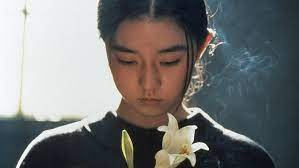
0 notes
Text
I never noticed the symbolism of things like the titular fireworks and the flower faces that Horibe saw, and while I noticed that Nishi’s wife did not speak for a majority of the movie, I didnt notice the symbolism of it. Really interesting!
'Hana-bi'
Hana-bi was such an interesting film to watch. The cinematography was beautiful. The pace of the film was purposefully and artistically slow, but the plot was so intense with everything happening that the film didn't actually feel slow.
I'm a bit uncertain of how to analyze this film in the context of Japanese society, because it really felt like a film that examined the philosophy of life that is universal to anyone around the world. While Nishi was the main character, Horibe was constantly juxtaposed after scenes of Nishi, encouraging the audience to see comparisons between them. While Nishi went out on an adventure with his wife, Horibe was bound at home because of his paralysis. Horibe's adventures were presented through the ideas and feelings being expressed in his art.
I interpreted the flower faces Horibe came up with in his mind as the emptiness of the beauty he used to have in his life. His paralysis along with his wife and child leaving him has left depressed and empty as he said he's never known anything other than work. He thinks about them and having family but flowers are placed in the faces because they are no longer there in his life.
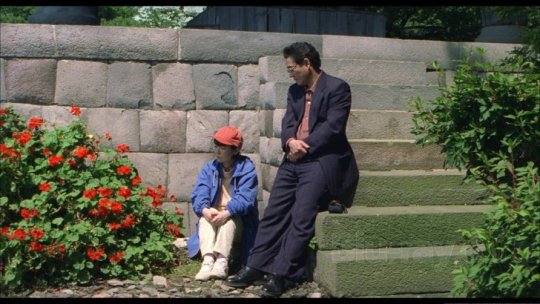
Fireworks to me seem like a beautiful grand explosion that is mesmerizing for a few seconds and disappears like nothing has ever been there before. I feel that Nishi chasing after adventures with his wife before she died was his way of setting a firework. Whereas Horibe's art is painting that is much more long-lasting, although it is not necessarily bringing him joy.
I also noticed that Nishi's wife never spoke until the end. It seems like she had really retreated from the world because of her illness and especially because of her child's death. Horibe mentioned at the beginning that she didn't say a word when he visited her at the hospital. However, I didn't realize that she wasn't speaking even to Nishi until close to the end. I liked that we got to know her through her games and places Nishi took her, because the silence allowed us to observe her and not focus on thinking about her illness or the fact that she is dying.
It felt to me that most people around Nishi seem to think they have a harder time than him. Moreover, they kept saying they didn't think anything was his fault but by saying that it implied that they were thinking he was part of the reason it happened. I think that kind of pressure and guilt would be too heavy for anyone to handle that I understand the painful outbreak Nishi had.
6 notes
·
View notes
Text
Hanabi
Before I start talking about the movie, I want to talk about a few things surrounding the movie. First, I accidentally thought that I saw the tag for comedy in this movie, so I went in thinking that it would be a comedic yakuza movie. It took around an hour for me to realize that this was not the case, which is a little embarrassing, but also really shaped my initial opinion. The second, is the actor choice. While watching the movie, I thought I saw some familiar faces, but I could not think of who I thought the actors played before. It was especially weird, since I barely have watched live action Japanese movies and tv shows outside of this class. After the movie, I looked it up, and that is when I found out that 2 of the main characters were from a totally different medium: Video Games. Firstly, the actor for the cop Nakamura, Susumu Terajima, played a cop in Yakuza 2 and its remake, and the games used his likeness too. The other person of note is the director and main actor, Takeshi Kitano. He also starred in Yakuza, his voice and likeness were used in Yakuza 6, not as a cop, but as a patriarch of a small yakuza family. Interestingly, his character in both this movie and in the game are pretty similar, they are both good people who have done bad things. Also of note, I subconsciously knew of Takeshi Kitano from a Youtube video I watched at a young age about a really old video game that he created, called Takeshi’s Challenge, which is a really interesting video game.
Now, onto the actual content of the movie.
I really liked this movie. The story was really good, and the cinematography was amazing. I think the main aspect of the movie that I really enjoyed was the setting. Many of the earlier movies that I had watched for this class had taken place in a time frame that I was not familiar with, but now that I am watching movies from from the 90s onward, the settings are way more modern.
The story was a really nice drama movie. The violence was highly exaggerated, which reminded me a lot about the yakuza series, which has the same amount of intense blood. The parallels between Nishi and Horibe is really well done, with Horibe coincidentally painting the stuff that Nishi does after robbing the bank. I thought it was really interesting that Horibe painted a painting of suicide in the snow, surrounded by light, when the main event that Nishi entangles himself in with the snow is his murder of 5 yakuza members. This is really interesting to me, since this could either be about one of two things. In the final scene, Nishi is implied to either have been shot, or have committed suicide, which could be what the suicide kanji in Horibe’s painting was, but I believe that it could be something else too. One of the yakuza members that Nishi murders had confronted him before, while Nishi was near a pond. In this scene, Nishi tells the yakuza member that if he ever sees Nishi again, Nishi is going to kill him. Despite this, he shows up in the scene where Nishi kills all the yakuza members, which could be seen as a suicide, since he could have stopped pursuing Nishi to live, but still went anyways.
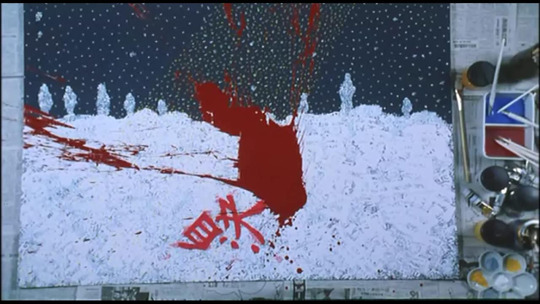
The cinematography and music were also top notch. The scenes where a certain motion gets transitioned into a similar motion from a different time or setting was really interesting. Specifically, I am talking about the scenes where Nishi lights a lighter, which transitions into a gunshot, and the scene where Nishi shoots someone, which transitions beautifully to Horibe spilling red paint on his suicide painting, which is a good bit of symbolism, as well as a nice fakeout, making viewers (me) think that Horibe actually killed himself. Overall, really good movie.
oh and i guess theres some anime movie also called hanabi/fireworks 🙄🙄
1 note
·
View note
Text
I also really liked the movie, despite the more light-hearted tone, it was really good. I didn’t know that Gun’s actor actually broke through to popular American films, thats really nice to know. The whole western theme with the cowboy hat and stuff was interesting, apparently the film is a Japanese version of a genre known as spaghetti western
Tampopo
Tampopo was a fun watch for me, but I’m glad we did not have to watch it with the rest of the class because there were some saucy bits in there I would not feel comfortable watching with a group of 20+ people. Tampopo is a comedy movie about a struggling widow trying to perfect the perfect ramen recipe in order to build a successful shop, and with how boring that plot sounds, it was crazy to see what Itami Juzo did to keep us on our seats.
Initial Reactions
For starters, it was interesting to see a young Ken Watanabe playing the role of Gun in the movie. It seems that in American cinema, there isn’t a large number of Japanese/Japanese-American superstars in the acting field, and so seeing Ken Watanabe made me feel glad that someone was able to break through that mold.

I also liked the irony in the beginning of the movie, where the “Man in the Suit” (for lack of a better term) chastises others for eating loud foods during a movie, despite the fact that the movie we’re about to watch is about ramen, a notoriously slurpy food. This character also has some of the best and strangest scenes, although I do hold some reservations about his morality, as the weird oyster scene with the young girl seems like he’s grooming her, which was kind of disgusting.
An interesting part of the movie that hopefully we might see in subsequent films is the inspiration it took from other films we have already seen. This is most notable in the formation of a ragtag ensemble of ramen experts being Seven Samurai-esque, and the whole film having a Western feel to it, with Goro’s cowboy outfit being the focal point of this. This really reinforces the impact of the old films we watched, and I much enjoyed it.
Themes/Analysis
To be completely honest, I couldn’t really pinpoint any themes that I felt were worth writing about. The determination of Tampopo to be the very best ramen cook (that no one ever was) might be the clearest theme to look at, but I feel as if analysis about that has been written into the ground already, as that’s a central plotline in so many movies. However, I feel something that might be worth writing about for this movie might be the that we don’t need themes to enjoy films, especially comedies. I didn’t go watch Ghostbustersto learn a deep lesson, and I don’t think Tampopo needs this level of analysis either; it’s just a fun movie with unique shots and stories that make it enjoyable to watch.

Final Thoughts
Tampopo is definitely up there in my rankings of movies for this class, despite the fact that it didn’t drive home a central message or have an overarching theme. It was a fun watch with wacky characters, even wackier hijinks, and beautiful food that made me hungry for some ramen.
6 notes
·
View notes
Text
Tampopo
Tampopo was almost a perfect movie. The movie is a charming story about a single mother learning how to make better ramen to help her business. The entire plotline with Tampopo learning to make ramen was really nice, it felt like a funny movie I could have watched in elementary school.
The humor was top notch here, I laughed a lot during the movie. The main story’s humor was really good, but I liked some of the little side stories. In the film, the side stories that were shown were completely for comedic value, and half of them are really funny. Watching the Tom and Jerry-esque antics of some old lady and a shop keeper was really hilarious.
The side stories were not all hits, however. I really did not like the side stories about the man in the white suit. The little scene at the beginning and end were pretty funny, but the 2 scenes in the middle in which he appeared were really weird, as well as the scene with the pearl diver. The usage of these side stories is a really nice way to move between scenes in the main plot without having to make some kind of segue between vastly differing shots. They also allow viewers to take a small break from the more serious story of the main plot for a quick laugh. These are very similar to how the anime Nichijou was set up (really good anime btw). My main problem with a few of the stories is the huge tonal shift. When the main story is a charming story about a single mother learning how to make ramen, an instant shift into a man in a white suit and a naked woman having what I can only describe as a food fetish is not what I want to see. All the other short scenes are about food in a comedic sense, and these scenes are not really comedic. Maybe they were meant to be comedic in some ironic sense of food being used erotically, but I did not find it funny at all. As an asexual, I am biased against more erotic scenes, and even unnecessary romantic scenes, so I was really offput by this. With the removal of those scenes, and a tweaking of certain other scenes, mainly the one where they kill that turtle :(, this movie could go from rated R to PG easily. These oddly out of place scenes are what I think makes this movie a bit under perfection.
The cinematography was really good. There were a few standout scenes, but most of the movie just featured solid standard cinematography. The cinematography in the various short stories was always really good, especially when transitioning into them. One example I can think of is the transition into the short story about the young worker who was knowledgeable about French food, which was a transition from Tampopo and Goro training into the various old rich people walking to the restaurant.
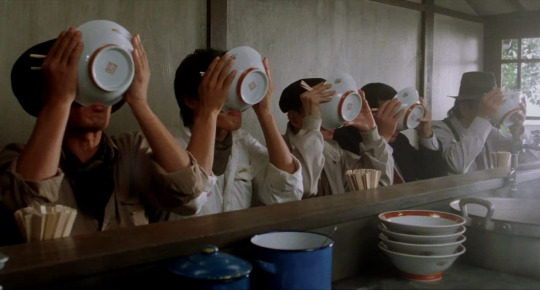
All lined up
0 notes